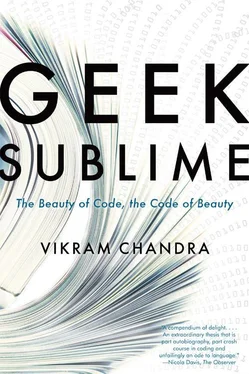The ubiquity of the Indian geek has been recognized even by popular American media in the figure of Raj Koothrappali, a character on the television show The Big Bang Theory. Raj is an astrophysicist at Caltech; he is mild, socially awkward, especially around women; he is effeminate by American standards (the other characters frequently suspect him of being gay); his parents try to run his life, so his attempts to live as an independent adult form one of the show’s running gags. “Koothrappali” is a Malayalam last name, or at least “Koothrappallil” is, so I’m guessing that Raj is supposed to be a south Indian, but he could well be the modern version of Sir Lepel Griffin’s hapless Bengali. These broad strokes catch precisely the larger culture’s notions of geeky Indianness, which — especially within the machismo of the IT industry — sometimes become a liability for Indians. In his autobiographical book, Dude, Did I Steal Your Job? Debugging Indian Programmers , N. Sivakumar recalls the advice he received when he first arrived in the US for a programming gig:
One of my friends advised me to walk smart. He told me that Americans think we are very humble and not smart enough to handle a crisis. He said that the way we walk in the company corridors itself portrays the shabbiness of Indians …
Most of the consulting companies and personal advisers tell the Indian programmers to behave smart and bold. They also advise them to be more aggressive, positive, and outspoken, so that Americans will love them. Most Indians lack all of these good qualities. Indians are no match to Americans when it comes to the above skills. 60
To anyone who has grown up within the Indian educational system, the notion that Indian techies would be regarded as “very humble” is puzzling. At my high school, we all knew which kids were preparing themselves for scientific or technical careers. We called them “Brains,” as in, “That Maitra is a huge Brain, he’ll surely get into IIT.” And the Brains were completely aware of their own superiority. Some of them had known at age ten that they were destined for one of the IITs or some similarly elite university; they knew because their families and teachers told them so, and they knew because their marks told them so. Every examination was ranked, and Maitra knew he had been “standing first” in class since first grade, just as the boy who was ranked forty-nine out of fifty knew exactly where he stood. Maitra also knew that the direction of his life could be determined by a fraction of a percentage point — if his desired college set its “cut-off marks” at 92.3 percent, a score of 92.2 percent would render him ineligible to apply. Maitra started waking up at 4:00 a.m. when he was thirteen, to attend a pre-school coaching class that prepared him to get into another nationally known coaching class that regularly placed its students into prominent universities. He knew that the names of students who got into nationally known institutions would be publicly announced along with their ranks, that pictures of the “top rankers” would appear in the newspapers, that they would be interviewed on prime-time television.
This educational process, with its obsessive emphasis on examinations and rankings, produces legions of rote learners, mark grubbers, and cheaters. It causes casualties—7,379 students committed suicide in 2010, an increase of 26 percent over 2005. 61It also produces fanatically disciplined and motivated competitors who are capable of decades of extraordinary concentration and ceaseless effort. But their competitiveness is couched in a cultural idiom that is not legible to many Americans, and therefore remains invisible or is read as general meekness or “shabbiness.”
This misreading works in both directions. I suspect I find David Barrett’s invocation of the ideal programmer as a “Lord of the Flies” who “grew up cooking squirrels over a campfire with sharpened sticks” so bizarre because my own cultural models of pioneering knowledge production come from the Indian scientists and technologists my classmates and I idolized during my childhood: J. C. Bose, S. Chandrasekhar, Homi J. Bhabha, Vikram Sarabhai. Whatever their actual caste or religion or beliefs may have been, these men seemed to embody Brahminical rectitude and austerity; they may have been as arrogant and ruthless and sexist as the American warrior-kings of software, but I’m completely unable to recast these particular Indians as gore-flecked paladins. In my mind, they are indubitably pandits, gyaani s, vidvaan s, aalim s, daanishmand s, seekers after eternal knowledge and therefore eternal students; they are all brain, their brawn is irrelevant. Their affect is rabbinical, detached from the humdrum worries of the everyday world. A famous verse describes the five qualities of the ideal scholar: “Far-seeing as the crow; concentrated as the stalking crane; light-sleeping as the hound; in control of the appetites; unencumbered by desires or a household.”
But within the mythologies of American nationhood and selfhood, from which Nick Carter the Killmaster and his low-yield nuclear grenade were born, innovation is conquest, and great programming makes “killer apps.” Californian cowboys range over the frontiers of knowledge, triumphing over the natural environment and its native denizens because of their toughness and tough-mindedness, their practicality, and their ability to blow away anything or anyone who stands in their path. Manifest destiny — with its cast of robber barons, tragically doomed natives, laboring Asians and African Americans, grizzled soldiers, and Lone Rangers — still casts its spell over the boardrooms and universities of America, and so the practitioners of some of the most nerdy professions in history (media-making; software-making; lending and borrowing money) develop codes of masculinity that allow them to “walk smart.”
In September 2011, the programmer Rob Spectre gave a presentation at a conference entirely in character as Chad the Brogrammer, wearing the standard fraternity-bro uniform of popped pink collar and dark glasses. A video of the presentation quickly went viral, and Spectre’s lines were suddenly all over the blogosphere: “In the immortal words of Brosef Stalin, ‘Dude, I’m way too faded to build this [difficult low-level] shiz. Imma have some other broheims do the grunge work. Totes magotes.’” 62Spectre was joking, but he had touched on a trend that many had noticed: “Tech’s latest boom,” Businessweek observed in 2012, “has generated a new, more testosterone-fueled breed of coder,” such as Danilo Stern-Sapad, a twenty-five-year-old who doesn’t like being called a geek, who “wears sunglasses and blasts 2Pac while programming,” who proudly reports that “we got invited to a party in Malibu where there were naked women in the hot tub. We’re the cool programmers.” 63So, in addition to the nerd machismo of the programmers and the buccaneer strutting of the venture capitalists, there is also now the frat-bro aggressiveness of young men who get into coding because it’s a cool-dude way to make stacks of cash.
In a 2012 Globe and Mail story about Canadian programmers in Silicon Valley, Alec Scott quotes a high-level female Canadian executive who’s worked with many of the top companies as saying:
People ask me, would you encourage your daughter to follow you into tech. My answer is no frickin’ way. I would tell a woman going in, you’re going to be 40 years old pitching a VC in the Valley, and he’s going to pinch your bum. I had that happen to me! … I got demoted [at a tech company] when I got pregnant. We’re not making progress in tech. If anything, it’s going the other way. 64

Читать дальше













